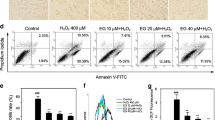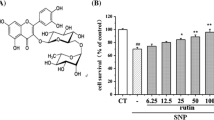Abstract
One of the plausible ways to prevent the reactive oxygen species (ROS)-mediated cellular injury is dietary or pharmaceutical augmentation of endogenous antioxidant defense capacity. In this study, we investigated the neuroprotective effect of fucoidan on H2O2-induced apoptosis in PC12 cells and the possible signaling pathways involved. The results showed that fucoidan inhibited the decrease of cell viability, scavenged ROS formation and reduced lactate dehydrogenase release in H2O2-induced PC12 cells. These changes were associated with an increase in superoxide dismutase and glutathione peroxidase activity, and reduction in malondialdehyde. In addition, fucoidan treatment inhibited apoptosis in H2O2-induced PC12 cells by increasing the Bcl-2/Bax ratio and decreasing active caspase-3 expression, as well as enhancing Akt phosphorylation (p-Akt). However, the protection of fucoidan on cell survival, p-Akt, the Bcl-2/Bax ratio and caspase-3 activity were abolished by pretreating with phosphatidylinositol-3-kinase (PI3K) inhibitor LY294002. In consequence, fucoidan might protect the neurocytes against H2O2-induced apoptosis via reducing ROS levels and activating PI3K/Akt signaling pathway.





Similar content being viewed by others
References
Ankacrona M, Dypbukt JM, Bonfoco E (1995) Glutamate-induced neuronal death: a succession of necrosis or apoptosis depending on mitochondrial function. Neuron 15(4):961–973
Blondin C, Chaubet F, Nardella A, Sinquin C, Jozefonvicz J (1996) Relationships between chemical characteristics and anticomplementary activity of fucans. Biomaterials 17(6):597–603
Cheung HH, Lynn Kelly N, Liston P, Korneluk RG (2006) Involvement of caspase-2 and caspase-9 in endoplasmic reticulum stress-induced apoptosis: a role for the IAPs. Exp Cell Res 312:2347–2357
Datta SR, Dudek H, Tao X, Masters S, Fu H, Gotoh Y, Greenberg ME (1997) Akt phosphorylation of BAD couples survival signals to the cell-intrinsic death machinery. Cell 91:231–241
Giorgio M, Trinei M, Migliaccio E, Pelicci PG (2007) Hydrogen peroxide: a metabolic by-product or a common mediator of ageing signals? Natl Rev Mol Cell Biol 8(9):722–728
Heo SR, Han AM, Kwon YK, Joung I (2009) p62 protects SH-SY5Y neuroblastoma cells against H2O2-induced injury through the PDK1/Akt pathway. Neurosci Lett 450(1):45–50
Jenner P (2003) Oxidative stress in Parkinson’s disease. Ann Neurol 53(Suppl. 3):S26–S36
Jia BS, Gao Y (2008) Protective effect of trihexyphenidyl on hydrogen peroxide-induced oxidative damage in PC12 cells. Neurosci Lett 437(1):50–54
Kim DK, Cho ES, Seong JK, Um HD (2001) Adaptive concentrations of hydrogen peroxide suppress cell death by blocking the activation of SAPK/JNK pathway. J Cell Sci 114(Pt 23):4329–4334
Lee SY, Ha TY, Son DJ, Kim SR, Hong JT (2005) Effect of sesaminol glucosides on β-amyloid-induced PC12 cell death through antioxidant mechanisms. Neurosci Res 52(4):330–341
Lee YM, Park SH, Shin DI, Hwang JY, Park B, Park Y, Lee JTH, Chae HZ, Jin BK, Oh TH, Oh YJ (2008) Oxidative modification of peroxiredoxin is associated with drug-induced apoptotic signaling in experimental models of Parkinson disease. J Biol Chem 283(15):9986–9998
Linnemann G, Reinhart K, Parade U, Philipp A, Pfister W, Straube E, Karzai W (2000) The effects of inhibiting leukocyte migration with fucoidan in a rat peritonitis model. Intensiv Care Med 26(10):1540–1546
Ma R, Xiong N, Huang C, Tang Q, Hu B, Xiang J, Li G (2009) Erythropoietin protects PC12 cells from beta-amyloid(25-35)-induced apoptosis via PI3K/Akt signaling pathway. Neuropharmacology 56(6–7):1027–1034
Mattson MP (ed) (2001) Mechanisms of neuronal apoptosis and excitotoxicity. In: Pathogenesis and Neurodegenerative disorders. Humana Press, Baltimore, pp 1–20
Misao J, Hayakawa Y, Ohno M, Kato S, Fujiwara T, Fujiwara H (1996) Expression of bcl-2 protein, an inhibitor of apoptosis, and Bax, an accelerator of apoptosis, in ventricular myocytes of human hearts with myocardial infarction. Circulation 94(7):1506–1512
Mohanty IR, Arya DS, Gupta SK (2008) Withania somnifera provides cardioprotection and attenuates ischemia–reperfusion induced apoptosis. Clin Nutr 27(4):635–642
Qin F, Liu YX, Zhao HW, Huang X, Ren P, Zhu ZY (2009) Chinese medicinal formula Guan-Xin-Er-Hao protects the heart against oxidative stress induced by acute ischemic myocardial injury in rats. Phytomedicine 16:15–221
Reed JC, Zha H, Aime-Sempe C, Takayama S, Wang HG (1996) Structure function analysis of Bcl-2 family proteins. Regulators of programmed cell death. Adv Exp Med Biol 406:99–112
Ryter SW, Kim HP, Hoetzel A, Park JW, Nakahira K, Wang X, Choi AM (2007) Mechanisms of cell death in oxidative stress. Antioxid Redox Signal 9(1):49–89
Sen P, Chakraborty PK, Raha S (2007) Activation of p38MAPK by repetitive low-grade oxidative stress leads to pro-survival effects. Biochim Biophys Acta 1773(3):367–374
Soubra L, Sarkis D, Hilan C, Verger P (2007) Dietary exposure of children and teenagers to benzoates, sulphites, butylhydroxyanisol (BHA) and butylhydroxytoluen (BHT) in Beirut (Lebanon). Regul Toxicol Pharm 47(1):68–77.
Wade C, Jackson R, Highton PG, van Rij AMJ (1987) Lipid peroxidation and malondialdehyde in the synovial fluid and plasma of patients with rheumatoid arthritis. Clin Chim Acta 164(3):245–250
Wang R, Zhang HY, Tang XC (2001) Huperzine A attenuates cognitive dysfunction and neuronal degeneration caused by beta-amyloid protein-(1–40) in rat. Eur J Pharmacol 421(3):149–156
Wang J, Zhang QB, Zhang ZS, Zhang JJ, Li PC (2009) Synthesized phosphorylated and aminated derivatives of fucoidan and their potential antioxidant activity in vitro. Int J Biol Macromol 44(2):170–174
Wang JY, Sun PP, Bao YM, Liu JW, An LJ (2010) Cytotoxicity of single-walled carbon nanotubes on PC12 cells. Toxicol In Vitro 25(1):242–250
Weinreb O, Amit T, Mandel S, Youdim M (2009) Neuroprotective molecular mechanisms of (−)-epigallocatechin-3-gallate: a reflective outcome of its antioxidant, iron chelating and neuritogenic properties. Genes Nutr 4(4):283–296
Yu Y, Du JR, Wang CY, Qian ZM (2008) Protection against hydrogen peroxide-induced injury by Z-ligustilide in PC12 cells. Exp Brain Res 184(3):307–312
Zhang G, Li P, Li Y, Liu X, Chen Y, Weng X, Yang Q, Zhu X (2011) Fucoidan by inhibiting cathepsin D activities alleviates PC12 apoptosis induced by hydrogen peroxide. Zhongguo Zhong Yao Za Zhi 36(8):1083–1086
Acknowledgments
This work was supported by the Natural Science Foundation of Shandong Province (No. ZR2011HL068).
Author information
Authors and Affiliations
Corresponding author
Rights and permissions
About this article
Cite this article
Gao, Y., Dong, C., Yin, J. et al. Neuroprotective Effect of Fucoidan on H2O2-Induced Apoptosis in PC12 Cells Via Activation of PI3K/Akt Pathway. Cell Mol Neurobiol 32, 523–529 (2012). https://doi.org/10.1007/s10571-011-9792-0
Received:
Accepted:
Published:
Issue Date:
DOI: https://doi.org/10.1007/s10571-011-9792-0




